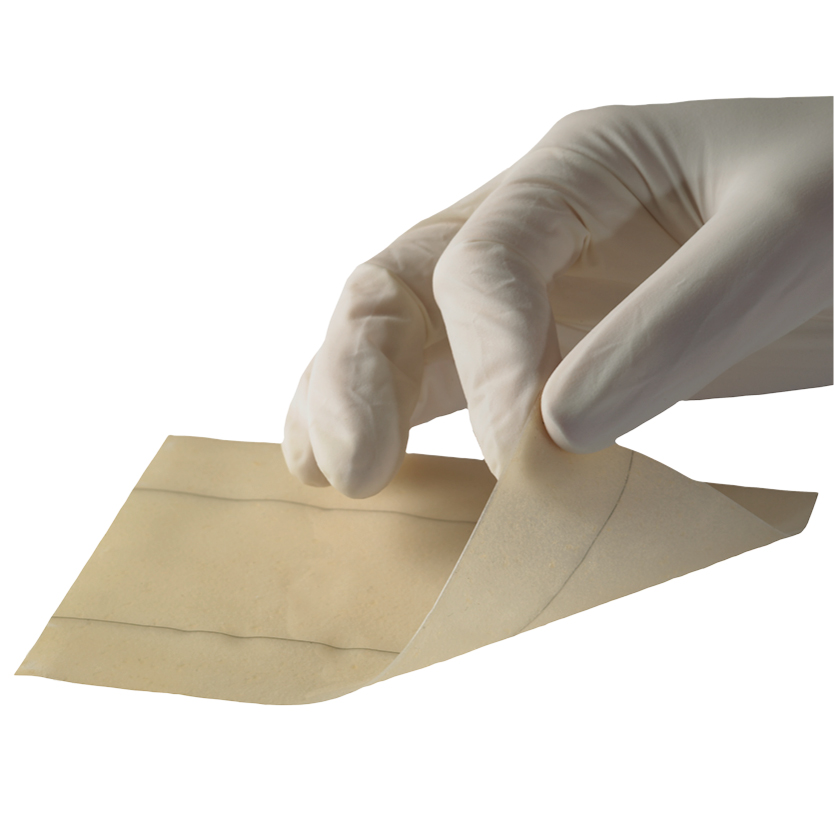
Integra® Bilayer Wound Matrix
Integra® Bilayer Wound Matrix is an advanced bilayer matrix device consisting of a porous, three-dimensional dermal layer and a temporary epidermal layer. The dermal layer (collagen and glycosaminoglycan) provides a scaffold for cellular invasion and capillary growth. The epidermal layer (polysiloxane) provides immediate wound closure, serves as a bacterial barrier and controls fluid loss.

Integra LifeSciences Corp.
Integra LifeSciences, a world leader in medical technology, is dedicated to limiting uncertainty for surgeons so they can concentrate on providing the best patient care. Integra offers innovative solutions in orthopedic extremity surgery, neurosurgery and reconstructive and general surgery.Benefits
• Provides immediate wound closure
• Highly conformable for various anatomic sites
• Provides a scaffold for cellular invasion and capillary growth
• Room temperature storage
Indications
Integra® Bilayer Wound Matrix is indicated for the management of wounds including: partial- and full-thickness wounds, pressure ulcers, venous ulcers, diabetic ulcers, chronic vascular ulcers, surgical wounds (donor sites/grafts, post-Mohs surgery, post-laser surgery, podiatric, wound dehiscence), trauma wounds (abrasions, lacerations, second-degree burns and skin tears) and draining wounds. The device is intended for one-time use.
Contraindications
This device should not be used in patients with known sensitivity to bovine collagen or chondroitin materials. This device is not indicated for use in third-degree burns.
Warnings and Precautions
Do not resterilize. Discard all opened and unused portions of the device. Do not use if package seal is broken.
Adverse Effects/Reactions
Complications are possible with the use of wound dressings including infection, chronic inflammation, allergic reaction, excessive redness, pain or swelling.
Storage Requirements
Room temperature with a 24-month shelf life.
How Supplied/Sizing
HCPCS Code
Product features
Other features
Recommended Use
Acute Wounds
Burns
Chronic Wounds
Deep Wounds
Diabetic Foot
Hypertrophic Scars/Keloids
Pressure Ulcers
Surgical Wounds
Venous Ulcers
Mode of Use/Application
Using aseptic technique, peel open the outer pouch and gently drop the inner foil pouch onto a sterile field or surface. Using sterile technique, place foil pouch flat and peel open the inner pouch. Remove product, including the protective polyethylene sheets. While holding the product with the tab, remove one polyethylene cover sheet. Turn the product and remove the second polyethylene cover sheet. Using the tab, the product can now be placed into a basin containing a sterile saline solution. Carefully remove the tab from the product while rinsing for one to two minutes. Keep product in the basin until application.
Prepare wound bed using standard methods to ensure wound is free of debris and necrotic tissue. If necessary, surgically debride the wound to ensure the wound edges contain viable tissue. Cut the device to size and apply immediately following wound bed preparation. Note: It is critical that the collagen layer be in direct contact with the prepared wound. The silicone layer, identified by the black threads, must be placed out (away from the wound bed). Do not apply upside down; the black threads must be clearly visible.
Integra® Bilayer Wound Matrix should be firmly secured using surgical staples, sutures or other mechanical means. Any air bubbles should be carefully removed to maintain contact with the wound. After application, use appropriate secondary dressings to maintain device adherence and protect the wound area. The optimum secondary dressing is determined by wound location, size, depth and user preference.
Removal & Change Frequency
Removal of silicone layer:
If edges of Integra® Bilayer Wound Matrix are loose before full healing has occurred, the silicone can be trimmed away from the loose areas until the entire wound has healed. Remove the silicone layer of the Integra® Bilayer Wound Matrix when the tissue underneath is healed, typically 14 to 28 days.
The Matrix may be loosen in spots. Remove by starting at one corner and pull gently. The silicone layer will peel off healed tissue relatively easily. Caution: If bleeding occurs, or if patient complains of excessive pain, stop and wait one to two additional days. Forced removal may result in wound re-injury.
Additional Recommended Dressings
Change the secondary dressings as needed. Frequency of secondary dressing change will be dependent upon volume of exudate produced, type of dressing used and the clinician's need to inspect the wound bed for signs of infection or healing.
No posters match your selected filters. Remove some filtres, or reset them and start again.
Have a product to submit?
Be included in the most comprehensive wound care products directory
and online database.
Learn More












Follow WoundSource
Tweets by WoundSource